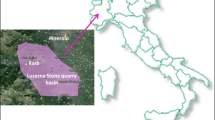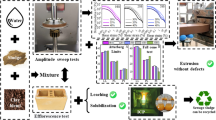Abstract
Residual sludge coming from dimension stone working activities represents a serious environmental and economic problem for both stone industry and community. Indeed, most of the time, residual sludge is landfilled because of the difficulties to recover it; such difficulties are mainly connected to local legislation and to a lack of proper protocols. In general, two different categories of sludge can be identified: residual sludge coming from carbonate rocks (CS) and those coming from silicate rocks (SS). Both of them are characterised by a very fine size distribution. CS is mainly made up of the same compounds of the processed stones (i.e. marble, limestone, travertine). On the contrary, SS is characterised by high heavy metal content, due to the composition of the tools employed during processing activities and to the original rock characteristics. Furthermore, total petroleum hydrocarbon content can often be recognised in residual sludge. In general, residual sludge, management of which in Italy is administered in accordance with ILD 152/06, can be used as waste for environmental restoration or for cement plants. Several researches investigate possible reuses of residual sludge, after a proper processing phase, as new products. Such “new products” should be certified not only on the basis of their technical and physical characteristics but also by means of appropriate chemical analyses to guarantee that the products are not polluted. The aim of this research was to evidence that, on the basis of a correct sludge characterisation, treatment and management, it is possible to produce secondary raw materials (filler, etc.) or new products (artificial soil, etc.), in order not to waste “sludge resources”. Some examples from Italian experimentations are here reported, focusing on the treatment and recovery of SS and CS.




Similar content being viewed by others
Abbreviations
- SRM:
-
Secondary raw materials
- NP:
-
New products
- CS:
-
Sludge from carbonate rocks
- SS:
-
Sludge from silicate rocks
- GSS:
-
Sludge from gangsaw using abrasive steel shot
- DBC:
-
Sludge from multi-diamond-saw block cutter
- MS:
-
Mixed sludge
- TPH:
-
Total petroleum hydrocarbon
- U:
-
Uniformity
- ILD:
-
Italian Legislative Decree
- IL:
-
Italian Law
- a.s.:
-
As such
- NA:
-
Not available
References
Almeida N, Branco F, Santos JR (2007) Recycling of stone slurry in industrial activities: Application to concrete mixture. Build Environ 42(2007):810–819
André A, de Brito J, Rosa A, Pedro D (2014) Durability performance of concrete incorporating coarse aggregates from marble industry waste. J Clean Prod 65:389–396
Barrientos V, Delgado J, Navarro V, Juncosa R, Falcón I, Vázquez A (2010) Characterization and geochemical–geotechnical properties of granite sawdust produced by the dimension stone industry of O Porriño (Pontevedra, Spain). Q J Eng GeolHydrogeol 43:141–155
Barros RJ, Jesus C, Martins M, Costa MC (2009) Marble stone processing powder residue as chemical adjuvant for the biologic treatment of acid mine drainage. Process Biochem 44(2009):477–480
Bertolini R, Celsi S (1989) Ipotesi di riutilizzo dei fanghi derivanti dalla lavorazione di materiali lapidei. Atti Convegno su: Situazione e Prospettive dell’Industria Lapidea. Cagliari, Italy, April 1989, pp 384–390 (in Italian)
Burragato F, Mecella G, Scandella P (1999) Waste muds from processing of the siliceous sands from Priverno: potential use for environmental rehabilitation. In: 2nd national congress “valorisation and recycling of industrial wastes”. L’Aquila, Italy, 5–8 July 1999
Careddu N, Cai O (2014) Granite sawing by diamond wire: from Madrigali “bicycle” to modern multi-wires. Diamante – Applicazioni & Tecnologia, n. 79, Anno 20, Dicembre 2014, pp 33–50. Ed. G & M Associated Sas
Careddu N, Marras G (2015) Marble processing for future uses of CaCO3-microfine dust: a study on wearing out of tools and consumable materials in stoneworking factories. Min Process Extr Metall Rev Int J 36(3):183–191
Careddu N, Marras G, Siotto G, Orrù G (2009) Recovery and reuse of marble powder contained in marble slurry waste. In: Ayhan M, Karakuş A, Özdemir Aydin M (Eds) Symposium papers of evaluation of marble wastes and decreasing environmental effects, Diyarbakir, Turkey, 16–17 October 2009. pp 62–69
Careddu N, Siotto G, Siotto R, Tilocca G (2013) From landfill to water, land and life: the creation of the Centre for stone materials aimed at secondary processing. Resour Policy 38(2013):258–265
Careddu N, Marras G, Siotto G (2014) Recovery of sawdust resulting from marble processing plants for future uses in high value added products. J Clean Prod 84(2014):533–539
Curreli L, Ferrara G, Ghiani M, Macchiavelli G, Pala M, Salaris M (1992) Produzione di feldspati per uso ceramico da rocce granitiche. Resoc Ass Min Sarda, anno XCV, pp 69–86 (in Italian)
Devant M, Cusidó JA, Soriano C (2011) Custom formulation of red ceramics with clay, sewage sludge and forest waste. Appl Clay Sci 53(2011):669–675
Díaz LA, Torrecillas R (2007) Porcelain stoneware obtained from the residual muds of serpentinite raw materials. J Eur Ceram Soc 27(2007):2341–2345
Dino GA, Fiora L, Fornaro M, Gambelli E, Sandrone R (2003) Sludge production and management in the Italian granite stone industry: an example from two granite basins in the alps—“industrial minerals and building stones” congress, IMBS 2003, Istanbul, Turkey 15–18 September 2003. pp 147–158. Ed. Erdogan Yurez
Dino GA, Fornaro M, Corio E, Fornaro E (2006) Residual sludge management: a possible reuse as loam. In: The 10th IAEG congress. Engineering geology for tomorrow’s cities, Nottingham, United Kingdom, 6–10 September 2006, pp 10
Dino GA, Clemente P, Lasagna M, De Luca DA (2013) Residual sludge from dimension stones: characterisation for their exploitation in civil and environmental applications. Energy Proced 40:507–514. doi:10.1016/j.egypro.2013.08.058
Dino GA, Passarella I, Ajmone Marsan F (2014) Quarry rehabilitation employing treated residual sludge from dimension stone working plant. Environ Earth Sci. doi:10.1007/s12665-014-3895-0
Dino GA, Clemente P, Lasagna M, Passarella I, Ajmone Marsan F, De Luca DA (2015) Industrial chance to recover residual sludge from dimension stones in civil and environmental applications. In: G Lollino, A Manconi, F Guzzetti, M Culshaw, P Bubrowsky, F Luino (Eds) Engineering geology for society and territory (Urban geology, sustainable planning and landscape exploitation), vol 5. Springer, Berlin, pp 1309–1313. doi:10.1007/978-3-319-09048-1_250
Felekoglu B (2007) Utilisation of high volumes of limestone quarry wastes in concrete industry (self-compacting concrete case). Resour Conserv Recycl 51(2007):770–791
Frisa Morandini A, Verga G (1990) Problemi connessi con lo smaltimento dei residui di lavorazione delle pietre ornamentali. Bollettino della Associazione Mineraria Subalpina, Anno XXVII, numero 1–2, pp 247–253
Galetakis M, Alevizos G, Leventakis K (2012) Evaluation of fine limestone quarry by-products, for the production of building elements—an experimental approach. Constr Build Mater 26(2012):122–130
Gencel O, Ozel C, Koksal F, Erdogmus E, Martínez-Barrera G, Brostow W (2012) Properties of concrete paving blocks made with waste marble. J Clean Prod 21(2012):62–70
IL (2016) Legge 28 dicembre 2015, n. 221. Disposizioni in materia ambientale per promuovere misure di green economy e per il contenimento dell’uso eccessivo di risorse naturali. GU Serie Generale n.13 del 18-1-2016 (in Italian)
ILD (2003) Decreto Legislativo 13 gennaio 2003, n. 36 “Attuazione della direttiva 1999/31/CE relativa alle discariche di rifiuti”. G.U. n. 59 del 12 marzo 2003 - Supplemento Ordinario n. 40 (in Italian)
ILD (2006) Ministero dell’Ambiente 2006. Norme in materia ambientale. Decreto Legislativo 3 aprile 2006, n. 152. Published in the Gazzetta Ufficiale n. 88 del 14 aprile 2006 - Supplemento Ordinario n. 96 (in Italian)
ILD (2012) Decreto del Ministero dell’Ambiente e della tutela del Territorio e del Mare 10 agosto 2012, n. 161. Regolamento recante la disciplina dell’utilizzazione delle terre e rocce da scavo, G.U. n. 221 del 21 settembre 2012 (in Italian)
Lee M, Ko C, Chang F, Lo S, Lin J, Shan M, Lee J (2008) Artificial stone slab production using waste glass, stone fragments and vacuum vibratory compaction. Cement Concr Compos 30(2008):583–587
Luodes H, Kauppila PM, Luodes N, Aatos S, Kallioinen J, Luukkanen S, Aalto J (2012) Characteristics and the environmental acceptability of the natural stone quarrying waste rocks. Bull Eng Geol Environ 71:257–261. doi:10.1007/s10064-011-0398-z
Marras G (2011) Recovery and valuation of ultrafine marble dust contained in waste slurries deriving from carbonatic natural stones processing plants. Ph.D. thesis, University of Cagliari (Italy). http://veprints.unica.it/644/
Marras G, Careddu N, Internicola C, Siotto G (2010a) Recovery and reuse of marble powder by-product. In: Proceedings of global stone congress 2010, 2–5 March 2010, Alicante, Spain. S3-01. Ed. AIDICO (Instituto de la Construcción), València. ISBN: 978-84-614-1147-4. Also published in Marmomacchine Magazine, n. 214, 2010, pp 34–48. Ed. Promorama. ISSN: 0392-6303
Marras G, Siotto G, Parra JL, Careddu N (2010b) Potential applications of waste material deriving from marble processing plants. In: Ersoy M, Çelik MY, Yeşilkaya L (eds) Proceedings of 7th international marble and natural stones congress of Turkey (Mersem VII), 14–15 October 2010, Afyonkarahisar, Turkey, pp 55–61. ISBN: 978-605-01-0023-5
Montani C (2014) XXV report marble and stones in the world 2014. Ed. Aldus Casa di Edizioni in Carrara, Italy
Montero MA, Jordán MM, Almendro-Candel MB, Sanfeliu MS, Hernández-Crespo MS (2009a) The use of a Calcium carbonate residue from the stone industry in manufacturing of ceramic tile bodies. Appl Clay Sci 43(2009):186–189
Montero MA, Jordán MM, Hernández-Crespo MS, Sanfeliu T (2009b) The use of sewage sludge and marble residues in the manufacture of ceramic tile bodies. Appl Clay Sci 46(2009):404–408
Pelino M, Cantalini C, Socchera A, Cisi G, Ullu F, Cabiddu P (1998) Aspetti scientifici e tecnologici di un impianto di vetrificazione di rifiuti industriali pericolosi. Atti del 4° Congresso Nazionale AIMAT, Chia Laguna (CA); Italy, 8–11/06/1998. AIMAT - PTM ed., pp 570–577 (in Italian)
Prescott PI, Pruett RJ (1996) Ground calcium carbonate: ore mineralogy, processing and markets. Min Eng 48(6):79–84. ISSN: 0026-5187
Primavori P (2008) Machinery and equipment for ornamental stone processing. In: Promorama s.r.l., Directory 2008, Milano, Italy
Rincón JM, Romero M (2010) Frits from natural stone wastes for obtention of composites applied as construction materials. In: Proceedings of global stone congress 2010, 2–5 March 2010, Alicante, Spain. S3-13. Ed. AIDICO (Instituto de la Construcción), València. ISBN: 978-84-614-1147-4
Saboya F Jr, Xavier GC, Alexandre J (2007) The use of the powder marble by-product to enhance the properties of brick ceramic. Constr Build Mater 21(2007):1950–1960
Sassone P, Danasino P (1995) Caratterizzazione di fanghi di segagione di Pietra di Luserna per la valorizzazione come materie prime secondarie. Atti del 2° Incontro Int. Giovani Ricercatori in Geologia Applicata (I.M.Y.R.A.G.), Peveragno (CN), 11–13 ottobre 1995, pp 510–515
Sivrikaya O, Kıyıldı KR, Karaca Z (2014) Recycling waste from natural stone processing plants to stabilise clayey soil. Environ Earth Sci 71:4397–4407
Sort X, Alcañiz JM (1996) Contribution of sewage sludge to erosion control in the rehabilitation of limestone quarries. Land Degrad Dev 7:69–76
Topçu IB, Bilir T, Uygunolu T (2009) Effect of waste marble dust content as filler on properties of self-compacting concrete. Constr Build Mater 23(2009):1947–1953
UNI EN 12440:2008 - Pietre naturali - Criteri per la denominazione
VV.AA. (1987) Atti Convegno Nazionale sul Granito. S.Ambrogio di Valpolicella (Italy), 18 Settembre 1987 (in Italian)
VV.AA. (1988) Atti 2° Convegno Nazionale sul Granito. Carrara (Italy), 4 Giugno 1988 (in Italian)
Acknowledgments
The authors would like to thank Prof. M. Fornaro, Eng. E. Fornaro and Eng. D. Mainero (ACEA Pinerolese), Dr. Massimo Marian (CSL VCO) and CIIAA VCO for their precious help at the basis of the present study (silicate sludge) and prof. G. Siotto for his continuous cooperation in dimension stone studies (carbonate sludge).
Author information
Authors and Affiliations
Corresponding author
Additional information
This article is part of a Topical Collection in Environmental Earth Sciences on “Geomaterials used as construction raw materials and their environmental interactions” guest edited by Richard Přikryl, Ákos Török, Magdalini Theodoridou and Miguel Gomez-Heras.
Rights and permissions
About this article
Cite this article
Careddu, N., Dino, G.A. Reuse of residual sludge from stone processing: differences and similarities between sludge coming from carbonate and silicate stones—Italian experiences. Environ Earth Sci 75, 1075 (2016). https://doi.org/10.1007/s12665-016-5865-1
Received:
Accepted:
Published:
DOI: https://doi.org/10.1007/s12665-016-5865-1




